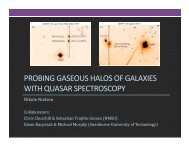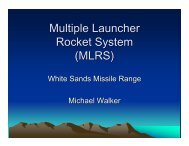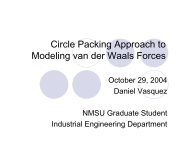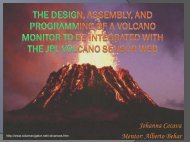Lightcurve Analysis and Photometry on CCD Images of Asteroids ...
Lightcurve Analysis and Photometry on CCD Images of Asteroids ...
Lightcurve Analysis and Photometry on CCD Images of Asteroids ...
You also want an ePaper? Increase the reach of your titles
YUMPU automatically turns print PDFs into web optimized ePapers that Google loves.
Why Study Rocks in Space?<br />
NASA’s new directi<strong>on</strong> includes a human<br />
missi<strong>on</strong> to a Near Earth Object (asteroid) by<br />
2025.<br />
A current hypothesis suggests the sporadic<br />
meteoroid background was produced by<br />
cometary breakups, rather than sublimati<strong>on</strong> <strong>of</strong><br />
ice <str<strong>on</strong>g>and</str<strong>on</strong>g> dust from comet surfaces.<br />
The sporadic meteoroid envir<strong>on</strong>ment<br />
c<strong>on</strong>sists <strong>of</strong> a diffuse background <strong>of</strong> meteoroids<br />
that represents a c<strong>on</strong>tinuous risk to spacecraft<br />
throughout the year. The Meteoroid<br />
Envir<strong>on</strong>ment Office (MEO) has developed the<br />
NASA MSFC Meteoroid Engineering Model<br />
(MEM) to define the sporadic meteoroid<br />
envir<strong>on</strong>ment for spacecraft in interplanetary<br />
space <str<strong>on</strong>g>and</str<strong>on</strong>g> Earth orbit.









